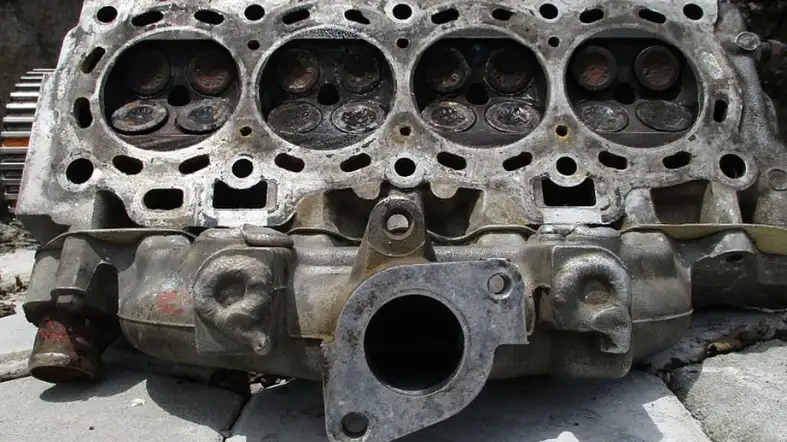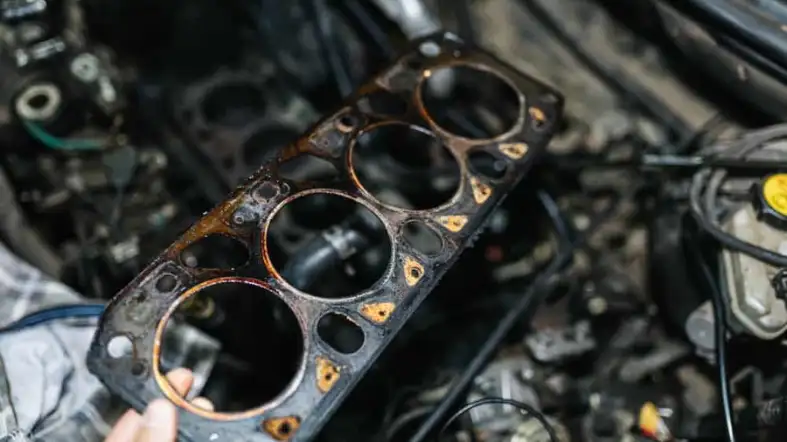Your car’s engine is complex machinery requiring multiple components to work perfectly.
One of the critical components of your engine is the head gasket.
This thin piece of metal or composite material seals the engine’s cylinders and prevents the coolant and oil from mixing.
A blown head gasket can cause significant problems with your engine and may even render it inoperable.
However, if you know what to look for, you can detect a blown head gasket early and prevent further damage to your engine.
What Are The First Signs Of A Blown Head Gasket?
The first signs of a blown head gasket can appear in various ways. Still, the most common symptoms include white or blue smoke coming from the exhaust, overheating of the engine, loss of engine power, or the presence of water or coolant in the engine oil or combustion chamber.

These symptoms occur due to the failure of the gasket to seal the space between the engine block and the cylinder head, which allows coolant and oil to mix and escape from their intended locations in the engine.
In addition, bubbles in the coolant reservoir, a sweet smell or frothy appearance in the oil, or a rough idle or misfire can all indicate a blown head gasket.
Repairing a blown head gasket can be costly and time-consuming, so it is essential to address these symptoms promptly to prevent further engine damage.
The Causes and Risks of a Blown Head Gasket in Your Vehicle
There are several causes of a blown head gasket, including:
Overheating:
When an engine overheats, the metal expands and pinches the head gasket so it no longer seals properly. This can cause a blown head gasket.
Pre-ignition:
Pre-ignition can cause the head gasket to fail by putting extra pressure on the gasket and causing it to fail.
A buildup of carbon deposits, incorrect ignition timing, or faulty spark plugs can cause this.
Improper installation:
If the head gasket is not installed properly during engine assembly, it may fail prematurely.
Engine age:
Over time, the head gasket can wear out and fail due to normal wear and tear.
Chemical damage:
If the engine is exposed to certain chemicals, such as engine coolant, it can cause the head gasket to fail.
Diagnosing a Blown Head Gasket: What You Need to Know

Here’s what you need to know to diagnose a blown head gasket:
Checking Engine Oil
One of the easiest and most effective ways to test if you have a blown head gasket is to take a look at your engine oil.
If you notice any unusual discoloration or a milky appearance, it could be a sign that coolant is leaking into the oil.
Overheating Engine
An overheating engine is another common symptom of a blown head gasket.
Coolant can leak into the cylinders when the head gasket is damaged, causing the engine to overheat.
Low Coolant Levels
If you notice that your coolant levels are consistently low, it could be a sign of a blown head gasket.
The head gasket plays a crucial role in keeping coolant and oil separate, so the coolant can leak out of the engine when it fails.
White Smoke from Exhaust
When coolant leaks into the combustion chamber, it can cause white smoke to come out of the exhaust pipe. This is a clear indication that the head gasket has failed.
Loss of Engine Power
A blown head gasket can also cause a loss of engine power. When coolant leaks into the cylinders, it can cause misfires and other issues that can affect the engine’s performance.
Bubble Test
You can also perform a bubble test to check for a blown head gasket. Start by removing the radiator cap and running the engine for a few minutes.
If bubbles form in the coolant, it could be a sign of a blown head gasket.
Coffee Color Test
Another way to test for a blown head gasket is to perform a coffee color test. Remove the oil filler cap and check if a coffee-colored liquid has formed in and around the cap.
If it has, it’s a telltale sign that the coolant has mixed with your oil, which means your head gasket has failed.
Block Test Kit
You can also use a block test kit to check for a blown head gasket.
This kit uses a chemical solution to detect the presence of exhaust gases in the cooling system, which can indicate a blown head gasket.
Preventing a Blown Head Gasket: Tips for Maintaining Your Vehicle

Here are some tips to keep in mind:
Check Your Coolant Levels Regularly
Checking your coolant levels is easy and can help prevent a blown head gasket. Simply open the hood and visually inspect the coolant level in the expansion coolant reservoir.
If the coolant is not at the “full” line, top it off with a compatible coolant like PEAK Long Life Antifreeze/Coolant.
Overheating due to low coolant levels is a common cause of blown head gaskets.
Monitor Engine Temperature
Keep an eye on your engine temperature gauge and be on the lookout for any unusual increases.
Overheating can lead to a blown head gasket, so if you notice the temperature gauge is higher than usual, take steps to cool the engine down immediately.
Causes of overheating include a clogged radiator, coolant leak, or faulty fan.
Regularly Check and Change Engine Oil
Changing your engine oil and oil filter is important for engine health and can help prevent a blown head gasket.
Regular oil changes keep engine parts lubricated and reduce the risk of overheating. Contaminated oil can cause damage to the engine and lead to head gasket failure.
Keep Up with Routine Maintenance
Regularly scheduled maintenance is critical to keeping your vehicle running smoothly and preventing a blown head gasket.
Make sure to follow the manufacturer’s recommended maintenance schedule and address any issues immediately.
Neglecting routine maintenance can lead to overheating and other problems that can cause head gasket failure.
Address Engine Performance Issues Immediately
Take action immediately if you notice any engine performance issues, such as power loss or rough running.
These issues can be signs of a blown head gasket, and ignoring them can lead to more severe engine damage.
Loss of power can result from a failed head gasket that allows compressed air/fuel to escape, reducing cylinder compression.
Consider Using a Head Gasket Sealer
If you suspect your head gasket is failing or want to prevent it from happening, you may want to consider using a head gasket sealer like BlueDevil Head Gasket Sealer.
This chemical sealing agent can seal a leak from a blown head gasket or a cracked or warped head.
However, it’s important to note that using a head gasket sealer is not a substitute for proper maintenance and can only provide a temporary fix.
Frequently Asked Questions
Can A Cylinder Misfire Be A Sign Of A Blown Head Gasket?
Yes, a cylinder misfire can signify a blown head gasket. If the head gasket is damaged, it can cause compression loss, leading to a misfire in one or more cylinders.
How Can I Tell If My Engine Is Overheating Due To A Blown Head Gasket?
If your engine is overheating, it could be a sign that the coolant has leaked to the point where it can’t effectively cool the engine.
You may also notice a service light or the temperature gauge may read unusually high.
What Are The Symptoms Of Oil Contamination Due To A Blown Head Gasket?
Oil contamination due to a blown head gasket can cause milky sludge on the underside of the oil filler cap or the dipstick, sometimes called a “milkshake” or “mayonnaise.”
This is caused by coolant getting into the oil and vice versa.
How Can A Loss Of Power Be A Sign Of A Blown Head Gasket?
In severe cases, a blown head gasket can cause a loss of power to the engine.
If the gasket fails, it can cause compression loss, leading to a decrease in engine power.
What Are Some External Signs Of A Blown Head Gasket?
One external sign of a blown head gasket is an oil or coolant leak at the seam between the engine block and cylinder head.
You can also check for cracks and cylinder head warping upon disassembly.
How Can Exhaust Smoke Be A Sign Of A Blown Head Gasket?
Steamy white smoke with a blueish tint coming from the exhaust pipe can signify a blown head gasket.
This condition is caused by the bad (blown) gasket allowing coolant to enter the combustion chamber and burn along with the fuel.
Conclusion:
A blown head gasket is a severe problem that requires immediate attention.
If you notice any of the symptoms we’ve discussed in this article, don’t hesitate to take your car to a mechanic.
A blown head gasket can cause significant damage to your engine and, if left untreated, can be expensive to repair.
By watching for the warning signs, you can detect a blown head gasket early and save yourself time, money, and hassle in the long run.
Remember to perform regular maintenance on your car, including checking your engine oil and coolant levels, to keep your engine running smoothly and prevent any problems from arising.
